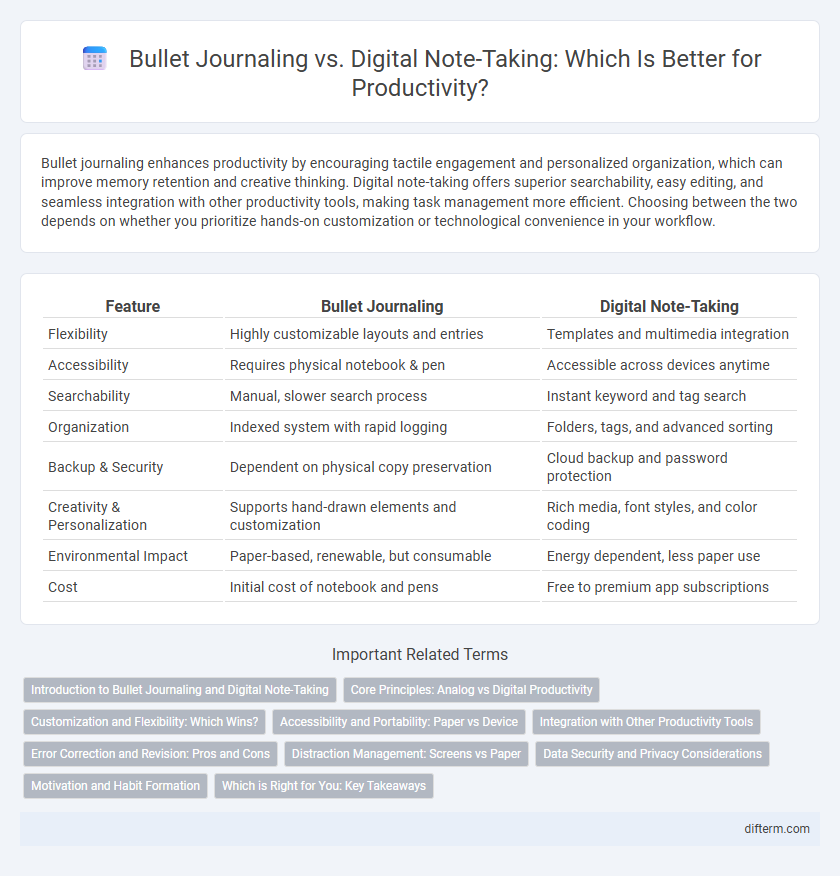Bullet journaling enhances productivity by encouraging tactile engagement and personalized organization, which can improve memory retention and creative thinking. Digital note-taking offers superior searchability, easy editing, and seamless integration with other productivity tools, making task management more efficient. Choosing between the two depends on whether you prioritize hands-on customization or technological convenience in your workflow.
Table of Comparison
| Feature | Bullet Journaling | Digital Note-Taking |
|---|---|---|
| Flexibility | Highly customizable layouts and entries | Templates and multimedia integration |
| Accessibility | Requires physical notebook & pen | Accessible across devices anytime |
| Searchability | Manual, slower search process | Instant keyword and tag search |
| Organization | Indexed system with rapid logging | Folders, tags, and advanced sorting |
| Backup & Security | Dependent on physical copy preservation | Cloud backup and password protection |
| Creativity & Personalization | Supports hand-drawn elements and customization | Rich media, font styles, and color coding |
| Environmental Impact | Paper-based, renewable, but consumable | Energy dependent, less paper use |
| Cost | Initial cost of notebook and pens | Free to premium app subscriptions |
Introduction to Bullet Journaling and Digital Note-Taking
Bullet journaling offers a tactile, customizable method for organizing tasks, goals, and reflections using analog tools like notebooks and pens, enhancing memory retention and mindfulness. Digital note-taking utilizes apps such as Evernote, OneNote, or Notion, providing searchable, cloud-synced platforms that streamline task management and collaboration. Both methods cater to different productivity preferences, with bullet journaling emphasizing creativity and personalization, while digital note-taking prioritizes efficiency and accessibility.
Core Principles: Analog vs Digital Productivity
Bullet journaling leverages analog productivity by encouraging tactile engagement, promoting mindfulness, and fostering customization through handwritten entries that enhance memory retention. Digital note-taking optimizes efficiency with searchability, cloud synchronization, and multimedia integration, facilitating rapid information access and seamless organization. Both systems embody core productivity principles: analog methods enhance cognitive processing, while digital tools amplify speed and connectivity.
Customization and Flexibility: Which Wins?
Bullet journaling offers unparalleled customization through hand-drawn layouts, personalized symbols, and flexible page organization, allowing users to tailor productivity systems to their unique needs. Digital note-taking apps provide dynamic flexibility with features like tagging, instant search, and multimedia integration, enabling rapid content adaptation and reorganization across devices. For users prioritizing tactile creativity and visual personalization, bullet journaling excels, whereas digital note-taking prevails for seamless editing and cross-platform accessibility.
Accessibility and Portability: Paper vs Device
Bullet journaling offers unmatched accessibility since it requires no battery or internet connection, making it reliable in any environment. Digital note-taking excels in portability, allowing users to store thousands of notes across devices synced in real time via cloud services. The choice between paper and digital largely depends on personal preference for tactile interaction versus seamless, on-the-go access to extensive digital archives.
Integration with Other Productivity Tools
Bullet journaling offers a tactile, customizable system that integrates physical planning with mental clarity but lacks direct synchronization with digital productivity tools. Digital note-taking apps, such as Evernote or OneNote, provide seamless integration with calendars, task managers, and cloud storage, enhancing workflow automation and real-time collaboration. Leveraging digital ecosystems enables syncing across devices, reminders, and linking notes to project management software, boosting overall efficiency.
Error Correction and Revision: Pros and Cons
Bullet journaling allows for immediate, hands-on error correction through erasing or crossing out, promoting tactile engagement that can enhance memory retention. Digital note-taking offers seamless revision capabilities with features like undo, spell check, and easy content rearrangement, increasing efficiency and accuracy. However, digital methods risk over-reliance on auto-correct and distractions, whereas bullet journaling's manual process may slow down rapid updates or error corrections.
Distraction Management: Screens vs Paper
Bullet journaling offers a distraction-free environment by eliminating digital interruptions such as notifications and app alerts, enhancing focus and task management. Digital note-taking provides quick access and searchability but risks frequent distractions from social media, emails, and multitasking on screens. Choosing paper-based bullet journaling supports sustained attention, while digital methods require disciplined usage to effectively manage digital distractions.
Data Security and Privacy Considerations
Bullet journaling offers enhanced data security and privacy by keeping sensitive information offline, reducing risks of hacking or unauthorized access. Digital note-taking apps often implement encryption and password protection, but remain vulnerable to data breaches or cloud service vulnerabilities. Users prioritizing confidentiality should weigh the balance between convenience and potential exposure when choosing their preferred productivity method.
Motivation and Habit Formation
Bullet journaling enhances motivation by providing a tactile, personalized experience that fosters mindfulness and accountability, making habit formation more intentional and visually rewarding. Digital note-taking offers convenience and flexibility with reminders and customizable templates, supporting consistent tracking and easy habit adjustments. Combining both methods can optimize productivity by leveraging the strengths of physical engagement and digital automation.
Which is Right for You: Key Takeaways
Bullet journaling offers tactile engagement and customizable layouts ideal for tactile learners and creativity enthusiasts, while digital note-taking provides seamless organization, searchability, and synchronization across devices, perfect for tech-savvy users who prioritize efficiency. Consider individual preferences, such as the desire for offline accessibility versus cloud-based convenience, and the importance of handwriting for memory retention compared to quick digital input. Evaluate your workflow needs, whether you require flexibility in design or integration with productivity apps, to determine the best method for optimizing task management and goal tracking.
Bullet journaling vs Digital note-taking Infographic

 difterm.com
difterm.com